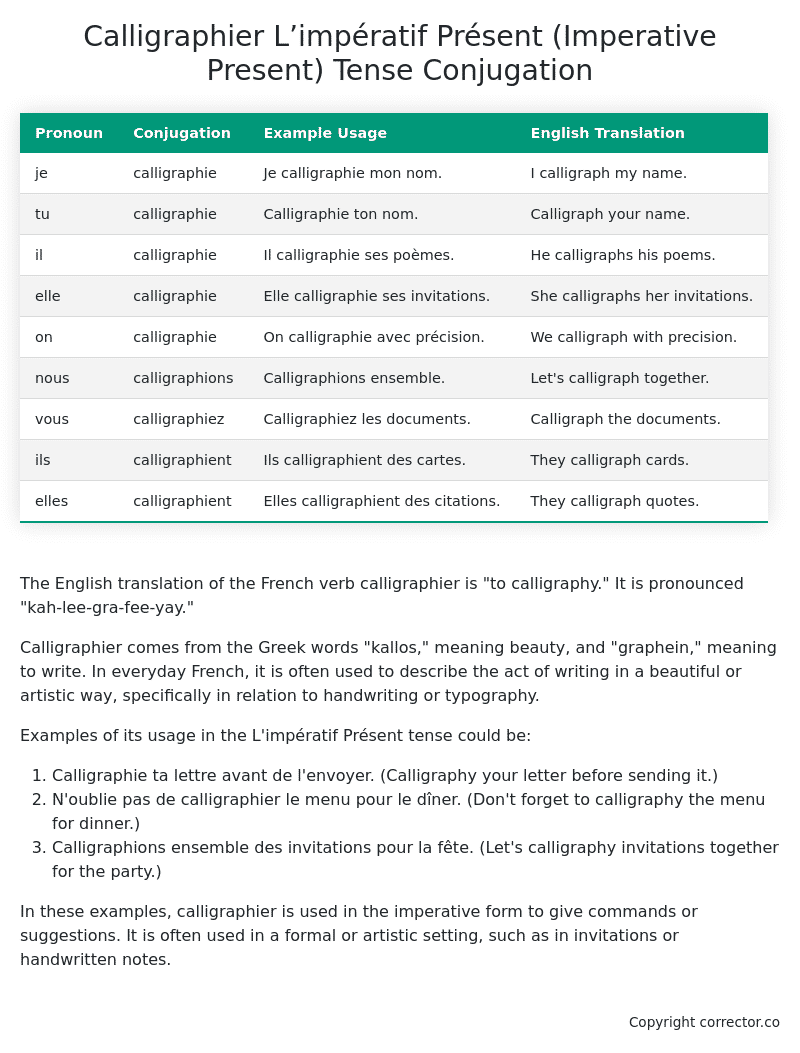L’impératif Présent (Imperative Present) Tense Conjugation of the French Verb calligraphier
Introduction to the verb calligraphier
The English translation of the French verb calligraphier is “to calligraphy.” It is pronounced “kah-lee-gra-fee-yay.”
Calligraphier comes from the Greek words “kallos,” meaning beauty, and “graphein,” meaning to write. In everyday French, it is often used to describe the act of writing in a beautiful or artistic way, specifically in relation to handwriting or typography.
Examples of its usage in the L’impératif Présent tense could be:
- Calligraphie ta lettre avant de l’envoyer. (Calligraphy your letter before sending it.)
- N’oublie pas de calligraphier le menu pour le dîner. (Don’t forget to calligraphy the menu for dinner.)
- Calligraphions ensemble des invitations pour la fête. (Let’s calligraphy invitations together for the party.)
In these examples, calligraphier is used in the imperative form to give commands or suggestions. It is often used in a formal or artistic setting, such as in invitations or handwritten notes.
Table of the L’impératif Présent (Imperative Present) Tense Conjugation of calligraphier
| Pronoun | Conjugation | Example Usage | English Translation |
|---|---|---|---|
| je | calligraphie | Je calligraphie mon nom. | I calligraph my name. |
| tu | calligraphie | Calligraphie ton nom. | Calligraph your name. |
| il | calligraphie | Il calligraphie ses poèmes. | He calligraphs his poems. |
| elle | calligraphie | Elle calligraphie ses invitations. | She calligraphs her invitations. |
| on | calligraphie | On calligraphie avec précision. | We calligraph with precision. |
| nous | calligraphions | Calligraphions ensemble. | Let’s calligraph together. |
| vous | calligraphiez | Calligraphiez les documents. | Calligraph the documents. |
| ils | calligraphient | Ils calligraphient des cartes. | They calligraph cards. |
| elles | calligraphient | Elles calligraphient des citations. | They calligraph quotes. |
Other Conjugations for Calligraphier.
Le Present (Present Tense) Conjugation of the French Verb calligraphier
Imparfait (Imperfect) Tense Conjugation of the French Verb calligraphier
Passé Simple (Simple Past) Tense Conjugation of the French Verb calligraphier
Passé Composé (Present Perfect) Tense Conjugation of the French Verb calligraphier
Futur Simple (Simple Future) Tense Conjugation of the French Verb calligraphier
Futur Proche (Near Future) Tense Conjugation of the French Verb calligraphier
Plus-que-parfait (Pluperfect) Tense Conjugation of the French Verb calligraphier
Passé Antérieur (Past Anterior) Tense Conjugation of the French Verb calligraphier
Futur Antérieur (Future Anterior) Tense Conjugation of the French Verb calligraphier
Subjonctif Présent (Subjunctive Present) Tense Conjugation of the French Verb calligraphier
Subjonctif Passé (Subjunctive Past) Tense Conjugation of the French Verb calligraphier
Subjonctif Imparfait (Subjunctive Imperfect) Tense Conjugation of the French Verb calligraphier
Conditionnel Présent (Conditional Present) Tense Conjugation of the French Verb calligraphier
Conditionnel Passé (Conditional Past) Tense Conjugation of the French Verb calligraphier
L’impératif Présent (Imperative Present) Tense Conjugation of the French Verb calligraphier (this article)
L’infinitif Présent (Infinitive Present) Tense Conjugation of the French Verb calligraphier
Struggling with French verbs or the language in general? Why not use our free French Grammar Checker – no registration required!
Get a FREE Download Study Sheet of this Conjugation 🔥
Simply right click the image below, click “save image” and get your free reference for the calligraphier L’impératif Présent tense conjugation!

Calligraphier – About the French L’impératif Présent (Imperative Present) Tense
Usage
Giving commands
Making requests
Offering advice
Expressing desires
Conjugation Formation
Interactions with other tenses
Want More?
I hope you enjoyed this article on the verb calligraphier. Still in a learning mood? Check out another TOTALLY random French verb conjugation!


